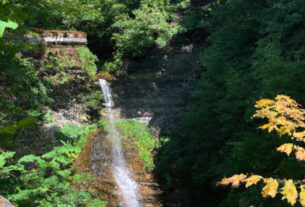If you’re looking for an extraordinary and unforgettable adventure in Japan, Snow Monkey Park is the place to be. Nestled in the northern Nagano prefecture, this park is home to a mesmerizing troop of Japanese macaques, affectionately known as snow monkeys, renowned for their fondness for hot springs.
More than just a tourist attraction, Snow Monkey Park is an integral part of Japanese culture. Featured in numerous documentaries, it has become an iconic symbol of Japan’s natural beauty. A visit to Snow Monkey Park is a must for anyone seeking an authentic encounter with the country’s wildlife and awe-inspiring wonders.
As someone fortunate enough to have experienced Snow Monkey Park firsthand, I can personally attest to its significance. The park’s breathtaking and tranquil landscape is utterly captivating, and observing the snow monkeys in their natural habitat is an indescribable, once-in-a-lifetime experience. Whether you’re a nature enthusiast, animal lover, or simply in search of something truly remarkable, Snow Monkey Park is the perfect destination for you.
So, let’s embark on an expedition into the captivating world of Snow Monkey Park and uncover why it holds such allure as a must-visit destination in Japan.
Location and History of Snow Monkey Park
Geographic Location of Snow Monkey Park
Situated in the Jigokudani valley of the Joshinetsu Kogen National Park in the northern Nagano prefecture of Japan, Snow Monkey Park is surrounded by picturesque forests and mountains. Located at an altitude of 850 meters, this valley experiences heavy snowfall in winter, creating an ideal habitat for the snow monkeys.
Historical Background of Snow Monkey Park
The park’s history traces back to the 1960s when a group of Japanese macaques was discovered utilizing the natural hot springs in the Jigokudani valley to warm up during winter. Originally intended for human use, the hot springs were quickly adopted by the monkeys, who have been frequenting them ever since.
In 1964, the park was officially established to protect the monkeys and their habitat. Over the years, it has evolved into a renowned tourist destination, attracting visitors from all corners of the globe.
How the Park Became a Popular Tourist Destination
Snow Monkey Park gained popularity in the 1980s and 1990s after being featured in several documentaries and travel programs. The park’s enchanting landscapes, combined with the charming behavior of the snow monkeys, captivated nature enthusiasts and animal lovers worldwide.
Today, Snow Monkey Park ranks among Japan’s most visited destinations, welcoming over 100,000 visitors every year. Its popularity has not only raised awareness about wildlife conservation but also provided economic benefits to the local community.
Now, let’s dive deeper into the park’s wildlife and discover what makes the snow monkeys so extraordinary.
Wildlife in Snow Monkey Park
Snow Monkey Park is home to a remarkable array of wildlife, but its most esteemed residents are undoubtedly the Japanese macaques, also known as snow monkeys. These captivating primates have stolen the hearts of visitors from around the world.
Overview of the Japanese macaques (snow monkeys)
Native to Japan, Japanese macaques are a species of Old World monkeys. With their distinctive red faces and short tails, they are highly adapted to the harsh winter climates of the Japanese Alps.
Snow monkeys are incredibly social creatures, living in large troops that can number in the hundreds. They exhibit a complex social hierarchy and demonstrate a wide range of behaviors, including grooming, play, aggression, and dominance displays.
Behavior and Characteristics of the Snow Monkeys
One of the most extraordinary aspects of snow monkeys is their affinity for hot springs. They are the only known non-human species to regularly indulge in hot spring bathing. Witnessing them soak in the steaming waters is an awe-inspiring experience that will remain etched in your memory.
Snow monkeys are renowned for their intelligence and adaptability. They showcase problem-solving skills and have been observed using tools to obtain food and water.
Significance of Hot Springs for the Snow Monkeys
The hot springs hold more than just relaxation for the snow monkeys; they play a crucial role in their survival. During the harsh winter months, the hot springs provide a warm and safe haven for the monkeys to rest and conserve energy. They serve as a safeguard against hypothermia and frostbite, enabling the monkeys to endure the challenging winter conditions.
In conclusion, the Japanese macaques are a truly remarkable species that warrant a visit to Snow Monkey Park. Whether you’re observing their social behaviors, admiring their bathing rituals in the hot springs, or simply reveling in their playful antics, these primates are guaranteed to leave an everlasting impression on anyone fortunate enough to encounter them.
Visiting Snow Monkey Park
Best Time to Visit Snow Monkey Park
Winter, from December to March, is the ideal season to explore Snow Monkey Park. During this time, the park is blanketed in snow, and the hot springs exude an irresistible allure. The snow monkeys are also most active during winter, relying on the hot springs to brave the frigid temperatures.
If you plan to visit during winter, remember to dress warmly and wear suitable footwear, as the park can be slippery. Additionally, be aware that the park can be crowded during peak season, so arriving early in the morning is advisable to avoid the masses.
How to Get to Snow Monkey Park
Reaching Snow Monkey Park is relatively straightforward. The nearest train station is Yudanaka, accessible from Tokyo by taking the Hokuriku Shinkansen to Nagano station and transferring to the Nagano Electric Railway. From Yudanaka station, hop on a bus or take a taxi to the park entrance.
Alternatively, a direct bus from Nagano station to the park entrance is available. The journey takes approximately 50 minutes, with a fare of 1,500 yen per person.
Entrance Fees and Other Practical Information
Snow Monkey Park charges an entrance fee of 800 yen per person. The park opens its doors from 8:30 am to 5:00 pm, with the last admission at 4:30 pm. Restrooms and a souvenir shop are present at the park entrance, but dining options are limited within the park, so it’s advisable to bring your own snacks and drinks.
It’s worth noting that feeding or touching the snow monkeys is strictly prohibited, as they are wild animals and can pose a danger. Park rangers diligently monitor the monkeys’ behavior and ensure that visitors adhere to the rules.
Things to Do in Snow Monkey Park
Observe the Snow Monkeys in Their Natural Habitat
Undoubtedly, the highlight of Snow Monkey Park is the Japanese macaques, famously known as snow monkeys. These endearing primates are renowned for their affinity for hot springs, which they utilize during the winter months to keep warm.
Visitors can observe the snow monkeys in their natural habitat from a safe distance. The park features several observation decks and trails that offer stunning views of the monkeys as they bathe in the hot springs, groom one another, and frolic around. Witnessing the snow monkeys in action is an enchanting and magical experience that will leave you in awe.
Take a Dip in the Hot Springs
After marveling at the snow monkeys’ enjoyment of the hot springs, why not indulge in a soak yourself? Snow Monkey Park provides several hot spring baths open to visitors. These baths are fed by natural hot springs and offer a unique and rejuvenating experience. Immerse yourself in the warm embrace of the hot springs while soaking in the park’s serene landscape — a perfect way to unwind and revitalize.
Explore the Surrounding Forests and Mountains
Snow Monkey Park extends beyond the realm of snow monkeys and hot springs. The surrounding forests and mountains beg to be explored. The park features a network of trails that guide visitors through the forests and lead to magnificent vistas of waterfalls, rivers, and lush vegetation. Venturing into the forests and mountains presents an opportunity to connect with nature and savor the splendor of Japan’s natural wonders.
In conclusion, Snow Monkey Park presents an array of activities catering to all types of visitors. Be it observing the snow monkeys, immersing yourself in the hot springs, or embarking on an adventure through the surrounding forests and mountains, Snow Monkey Park guarantees unforgettable memories.
Conclusion
In summary, Snow Monkey Park is an essential destination in Japan for those seeking an exceptional and unforgettable experience. Its significance in Japanese culture, coupled with its breathtaking natural beauty, make it an unmissable attraction. Witnessing the snow monkeys in their natural habitat and indulging in the hot springs is an encounter that cannot be replicated anywhere else in the world.
As impassioned nature enthusiasts and animal lovers, we wholeheartedly recommend a visit to Snow Monkey Park. The park’s serene landscapes, captivating wildlife, and cultural significance combine to make it an unforgettable destination. So, when planning your trip to Japan, ensure that Snow Monkey Park finds its way onto your itinerary. You won’t regret it!
At TooLacks, our passion lies in promoting nature and wildlife, and we are committed to sharing information about the world’s most captivating destinations. To learn more about other natural wonders, please visit our website. Here, you’ll discover articles covering gardening, animals, and all things related to nature. Let us inspire your love for the natural world.


